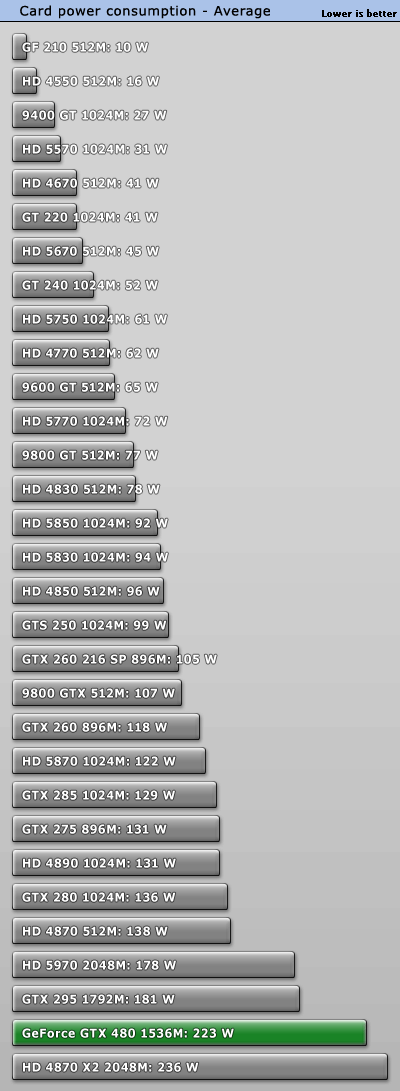 830
830
NVIDIA GeForce GTX 480 Fermi Review
Fan Noise »Power Consumption
Cooling modern video cards is becoming more and more difficult, especially when users are asking for quiet cooling solutions. That's why the engineers are now paying much more attention to power consumption of new video card designs.For this test we measure power consumption of only the graphics card, via PCI-Express power connector(s) and PCI-Express bus slot. A Keithley Integra 2700 with 6.5 digits is used for all measurements. Again, the values here reflect card only power consumption measured at DC VGA card inputs, not the whole system.
We chose 3DMark03 Nature as a standard test representing typical 3D usage because it offers: - very high power draw - high repeatability - is a standard benchmark that is supported by all cards - drivers are actively tested and optimized for it - supports all multi-GPU configurations - easy to obtain - fairly compact in size - test runs a constant duration and renders a variable scene with variable complexity just like any normal game.
The four result values are as following:
- Idle: Windows Vista Aero sitting at the desktop (1280x1024 32-bit) all windows closed, drivers installed. Card left to warm up in idle until power draw is stable.
- Average: 3DMark03 Nature at 1280x1024, 6xAA, 16xAF. This results in the highest power consumption. Average of all readings (12 per second) while the test was rendering (no title screen).
- Peak: 3DMark03 Nature at 1280x1024, 6xAA, 16xAF. Highest single reading during the test.
- Maximum: Furmark Stability Test at 1280x1024, 0xAA. This results in a very high non-game power consumption that can typically be reached only with stress testing applications. Card left running stress test until power draw converged to a stable value.
- Blu-Ray Playback: Power DVD 9 Ultra is used at a resolution of 1920x1200 to play back the Batman: The Dark Knight disc with GPU acceleration turned on. Playback starts around timecode 1:19 which has the highest data rates on the BD with up to 40 Mb/s. Playback left running until power draw converged to a stable value.
In idle the power consumption of the card is simply unacceptable. AMD's HD 5000 Series is basically 3x as efficient here compared to NVIDIA's latest product. When you look at the rendering performance of GTX 480 it is roughly similar to GTX 295. In most of our tests, we see the GTX 480 close to the GTX 295 in regards to power consumption.
From this I infer that NVIDIA is simply using the same methods to save power as on GT200. But with more transistors power has to go up accordingly - at least in an NVIDIA world. AMD on the other hand have basically reinvented themselves with their current generation, their cards deliver substantially lower power than the previous cards at the same or lower power draw. So in my opinion, the GF100 chip design is roughly as efficient as the GT200 design, but this doesn't seem to be enough to deliver a competitive solution nowadays in the power/heat/noise area.
I'm also not sure how much more room there is for improvements, in idle NVIDIA runs the card at clocks of 50 MHz core, 68 MHz memory and 100 MHz shaders!





Mar 6th, 2025 08:11 EST
change timezone
Latest GPU Drivers
New Forum Posts
- Get 9070 or 9070 XT (42)
- Flashing Rx7900xtx (1)
- Windows 11 General Discussion (5834)
- intel 1700 with high speed ram,memory (18)
- Post your 7-Zip v22.01 scores (412)
- 6TB Iron Wolf $110 (7)
- TPU's Nostalgic Hardware Club (20059)
- GameTechBench GPU benchmark is already out! (302)
- Will I benefit from changing the thermal pad? (23)
- I'm looking for a good tool to make the 3D scanning of my mini-pc using the photogrammetry and my Kinect 2. (2)
Popular Reviews
- Sapphire Radeon RX 9070 XT Nitro+ Review - Beating NVIDIA
- NVIDIA GeForce RTX 5070 Founders Edition Review
- ASUS Radeon RX 9070 TUF OC Review
- AMD Radeon RX 9070 Series Technical Deep Dive
- EIZO FlexScan EV4340X Review - A Multitasking Powerhouse
- RAWM ES21M Review
- ASUS GeForce RTX 5070 Ti TUF OC Review
- AMD Ryzen 7 9800X3D Review - The Best Gaming Processor
- MSI GeForce RTX 5070 Ti Vanguard SOC Review
- MSI GeForce RTX 5070 Ti Ventus 3X OC Review
Controversial News Posts
- NVIDIA GeForce RTX 50 Cards Spotted with Missing ROPs, NVIDIA Confirms the Issue, Multiple Vendors Affected (513)
- AMD Plans Aggressive Price Competition with Radeon RX 9000 Series (277)
- AMD Radeon RX 9070 and 9070 XT Listed On Amazon - One Buyer Snags a Unit (261)
- AMD Mentions Sub-$700 Pricing for Radeon RX 9070 GPU Series, Looks Like NV Minus $50 Again (248)
- NVIDIA Investigates GeForce RTX 50 Series "Blackwell" Black Screen and BSOD Issues (244)
- AMD RDNA 4 and Radeon RX 9070 Series Unveiled: $549 & $599 (241)
- AMD Radeon RX 9070 and 9070 XT Official Performance Metrics Leaked, +42% 4K Performance Over Radeon RX 7900 GRE (195)
- AMD Radeon RX 9070-series Pricing Leaks Courtesy of MicroCenter (158)